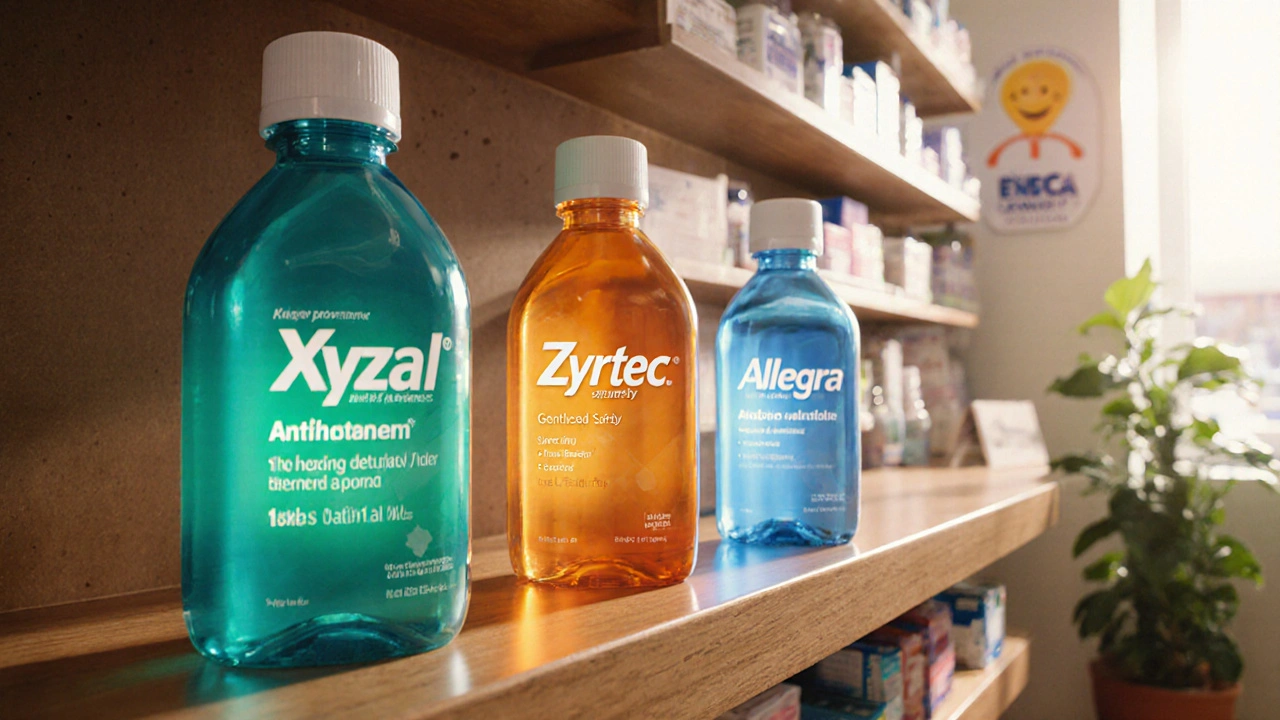Antihistamine Comparison Tool
Select options below to compare antihistamines:
| Drug | Generation | Dose | Sedation Risk | Onset of Relief | Duration | OTC Status |
|---|---|---|---|---|---|---|
| Levocetirizine (Xyzal) | 2nd | 5 mg once daily | Low | ≈1 hour | ≈24 hours | Prescription (OTC in some EU countries) |
| Cetirizine (Zyrtec) | 2nd | 10 mg once daily | Low-moderate | ≈1 hour | ≈24 hours | OTC |
| Loratadine (Claritin) | 2nd | 10 mg once daily | Very low | ≈2 hours | ≈24 hours | OTC |
| Fexofenadine (Allegra) | 2nd | 180 mg once daily | Very low | ≈2-3 hours | ≈12 hours | OTC |
Levocetirizine is the active ingredient in Xyzal, a second‑generation H1‑receptor antagonist used to treat allergic rhinitis and chronic urticaria.
TL;DR - Quick Takeaways
- Levocetirizine offers fast relief with low sedation, making it a top pick for daytime use.
- Cetirizine is the parent racemate; cheaper but slightly more sedating.
- Loratadine and fexofenadine are equally non‑sedating but start working a bit slower.
- First‑generation drugs like diphenhydramine are cheap and very sedating - reserve for night‑time or short‑term.
- Cost, pregnancy safety and pediatric dosing often decide the final choice.
How Levocetirizine Works - The Pharmacology Bite
When allergens hit the nose or skin, they trigger mast cells to release histamine. Histamine then binds to H1 receptors, causing itching, swelling and a runny nose. Levocetirizine blocks those H1 receptors, preventing the cascade. Because it’s the pure (R)-enantiomer of cetirizine, it binds more tightly, delivering the same effect at half the dose. The drug is absorbed within an hour, peaks in the blood after 1‑2hours, and stays active for roughly 24hours, which is why most patients take it once daily.
Meet the Competitors - Key Antihistamines on the Market
Cetirizine is the racemic mixture from which levocetirizine is derived. It’s a second‑generation antihistamine, widely available over‑the‑counter in many countries.
Loratadine is another second‑generation H1 blocker, marketed under names like Claritin. It has a very low sedation profile and is commonly used for seasonal allergies.
Fexofenadine (Allegra) is a non‑sedating second‑generation antihistamine that works a little slower but lasts up to 12hours per dose.
Desloratadine is the active metabolite of loratadine, offering a similar safety profile with a slightly quicker onset.
Diphenhydramine is a first‑generation antihistamine (Benadryl) that crosses the blood‑brain barrier, causing pronounced drowsiness.
Chlorpheniramine is another first‑generation option, often found in combination cold‑and‑flu formulas.
Side‑by‑Side Comparison Table
| Drug | Generation | Typical Adult Dose | Onset of Relief | Duration | Sedation risk | OTC status (US) |
|---|---|---|---|---|---|---|
| Levocetirizine (Xyzal) | 2nd | 5mg once daily | ≈1hour | ≈24hours | Low | Prescription (OTC in some EU countries) |
| Cetirizine (Zyrtec) | 2nd | 10mg once daily | ≈1hour | ≈24hours | Low‑moderate | OTC |
| Loratadine (Claritin) | 2nd | 10mg once daily | ≈2hours | ≈24hours | Very low | OTC |
| Fexofenadine (Allegra) | 2nd | 180mg once daily | ≈2‑3hours | ≈12hours | Very low | OTC |
| Desloratadine (Clarinex) | 2nd | 5mg once daily | ≈1‑2hours | ≈24hours | Very low | Prescription (OTC in UK) |
| Diphenhydramine (Benadryl) | 1st | 25‑50mg every 4‑6h | ≈30minutes | ≈4‑6hours | High (sedating) | OTC |
| Chlorpheniramine | 1st | 4mg every 4‑6h | ≈30‑60minutes | ≈6hours | Moderate‑high | OTC |
Efficacy - Does Levocetirizine Actually Work Better?
Clinical trials from 2020‑2023 show that levocetirizine improves nasal symptom scores by about 30% more than placebo and matches cetirizine’s relief while using half the dose. For chronic urticaria, the 2022 EAACI guideline rates levocetirizine as “high‑evidence” for reducing wheal size within 24hours.
Loratadine and fexofenadine deliver comparable symptom control for mild‑to‑moderate seasonal allergies, but patients with a heavy pollen load often report needing two daily doses of fexofenadine to match the 24‑hour coverage that levocetirizine gives with a single pill.
First‑generation agents like diphenhydramine are excellent for acute itching or night‑time allergic flare‑ups, but their sedative effect makes them unsuitable for regular daytime use.

Safety Profile - What Side Effects Should You Watch For?
Levocetirizine’s most common adverse events are mild headache (≈5%) and dry mouth (≈3%). Because it doesn’t cross the blood‑brain barrier easily, daytime drowsiness is rare (≈2%).
Cetirizine shares a similar safety profile, but the higher dose can bump sedation up to 5‑7% in sensitive individuals. Loratadine and fexofenadine have the lowest sedation rates (<1%).
First‑generation drugs are notorious for anticholinergic side effects - dry mouth, blurred vision, urinary retention - especially in older adults. Chronic use is discouraged for people with glaucoma or prostate enlargement.
Pregnancy safety data: levocetirizine is Category B (no evidence of risk in animal studies, limited human data). Loratadine and cetirizine share the same classification. Diphenhydramine is also Category B but its sedative effect can affect sleep architecture, so doctors often recommend non‑sedating alternatives.
Cost, Availability and Practical Considerations
In the UK, a 30‑day supply of levocetirizine (5mg tablets) costs around £12‑£14 on the NHS prescription form and £15‑£18 over the counter. Generic cetirizine is typically £5‑£7 for the same period, making it the budget‑friendlier option.
Loratadine and fexofenadine sit in the £8‑£12 range OTC. Desloratadine is slightly pricier, usually £13‑£16, but its once‑daily 5mg dose may justify the cost for patients needing rapid onset.
First‑generation antihistamines are the cheapest - diphenhydramine tablets can be bought for £2‑£4 a pack, but the hidden cost is lost productivity due to sleepiness.
Insurance formularies often place levocetirizine in a higher tier, requiring prior authorization. That’s why many clinicians start patients on cetirizine or loratadine and switch to levocetirizine only if symptoms persist.
Choosing the Right Antihistamine - A Simple Decision Tree
- Do you need 24‑hour, non‑sedating relief for work or school? Levocetirizine or cetirizine are solid choices; pick levocetirizine if you prefer a lower dose.
- Is cost the main driver? Go with generic cetirizine or loratadine.
- Do you have a history of severe drowsiness with antihistamines? Choose loratadine, fexofenadine, or desloratadine - they have the lowest sedation rates.
- Are you treating night‑time itching or need rapid short‑term relief? Diphenhydramine works fast but will make you sleepy.
- Pregnant or breastfeeding? Stick with levocetirizine, cetirizine or loratadine after consulting a clinician.
This flowchart helps you narrow down the field without wading through pharmacy aisles for hours.
Related Concepts - Why Understanding Histamine Helps You Pick Better
Histamine isn’t just a sneeze trigger; it also plays a role in stomach acid secretion, neurotransmission, and immune regulation. Knowing that second‑generation antihistamines target peripheral H1 receptors while sparing central receptors explains why they cause far less drowsiness.
Another linked topic is allergic rhinitis, a condition affecting up to 30% of adults in temperate climates. Effective management often combines an antihistamine with nasal saline irrigation or intranasal corticosteroids.
For chronic urticaria, H1‑receptor blockade is only the first step; many patients eventually need omalizumab or cyclosporine if antihistamines alone don’t control hives.
Next Steps - How to Put This Knowledge Into Action
1. Review your symptom pattern (seasonal vs perennial, daytime vs night‑time).
2. Check your current medication list for potential drug‑drug interactions - levocetirizine is metabolized by CYP3A4, so avoid strong inhibitors like ketoconazole without medical advice.
3. Talk to your GP or pharmacist. Ask specifically about a trial of levocetirizine if you’ve struggled with sedation on other antihistamines.
4. If cost is an issue, request a generic cetirizine prescription; it’s clinically comparable for most people.
5. Keep a simple diary for two weeks: note dosing time, symptom scores, and any drowsiness. This data helps your clinician fine‑tune the choice.
Frequently Asked Questions
Is levocetirizine stronger than cetirizine?
Levocetirizine is the pure (R)-enantiomer of cetirizine, so it delivers the same H1‑blocking effect at roughly half the dose. In practice, most users feel the same level of relief, but the lower dose can mean fewer side effects for some people.
Can I take levodicetirizine with other allergy meds?
Yes, it’s common to combine a second‑generation antihistamine with an intranasal corticosteroid for severe allergic rhinitis. Avoid mixing with other sedating antihistamines or MAO‑inhibitors without doctor approval.
Is levocetirizine safe for kids?
The UK and US label it for children 6years and older at a 2.5mg dose once daily. For younger children, doctors usually prefer cetirizine or a pediatric‑friendly formula of loratadine.
Will levocetirizine make me drowsy?
Sedation rates are low - around 2% of users report noticeable drowsiness. If you’re sensitive, taking the tablet with food and at the same time each day can help minimise any sleepy feelings.
How does the cost of levocetirizine compare to generic options?
Levocetirizine is usually priced 2‑3 times higher than generic cetirizine because it’s a brand‑name or patented formulation. If budget is tight, many clinicians start with cetirizine and switch only if you need the lower dose or experience side effects.


Written by Felix Greendale
View all posts by: Felix Greendale